
The bell pepper is the fruit of plants in the Grossum Group of the species Capsicum annuum. Cultivars of the plant produce fruits in different colors, including red, yellow, orange, green, white, chocolate, candy cane striped, and purple. Bell peppers are sometimes grouped with less pungent chili varieties as "sweet peppers". While they are botanically fruits—classified as berries—they are commonly used as a vegetable ingredient or side dish. Other varieties of the genus Capsicum are categorized as chili peppers when they are cultivated for their pungency, including some varieties of Capsicum annuum.

Chili peppers, colloquially spelled chile or chilli, are varieties of the berry-fruit of plants from the genus Capsicum, which are members of the nightshade family Solanaceae, cultivated for their pungency. Chili peppers are widely used in many cuisines as a spice to add "heat" to dishes. Capsaicin and related compounds known as capsaicinoids are the substances that give chili peppers their intensity when ingested or applied topically. Chili peppers exhibit a wide range of heat and flavors. This diversity is the reason behind the availability of different types of paprika and chili powder, each offering its own distinctive taste and heat level.

Capsicum annuum var. glabriusculum, a chili-pepper variety of Capsicum annuum, is native to southern North America and northern South America. Common names include chiltepín, Indian pepper, grove pepper, chiltepe, and chile tepín, as well as turkey, bird’s eye, or simply bird peppers. Tepín is derived from a Nahuatl word meaning "flea". This variety is the most likely progenitor of the domesticated C. annuum var. annuum. Another similar-sized pepper, 'Pequin' is often confused with tepin, although the tepin fruit is round to oval where as the pequin's fruit is oval with a point, and the leaves, stems and plant structures are very different on each plant.
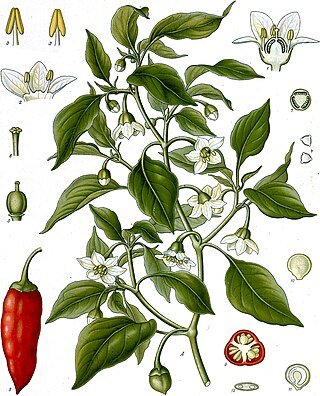
Capsicum annuum is a fruiting plant from the family Solanaceae (nightshades), within the genus Capsicum which is native to northern region of South America, and southwestern North America. The plant produces berries of many colors including red, green, and yellow, often with pungent taste. It also has many varieties and common names including paprika, chili pepper, jalapeño, cayenne, bell pepper, and many more with over 200 variations within the species. It is also one of the oldest cultivated crops, with domestication dating back to around 6,000 years ago in regions of Mexico. The genus Capsicum has over 30 species but Capsicum annuum is the primary species in its genus, as it has been widely cultivated for human consumption for a substantial amount of time and has spread across the world. This species has many uses in culinary applications, medicinal uses, self defense, and can even be ornamental. With high levels of cultivation the species is cared for greatly and globaly, though there are still some pests and diseases that can impact the species.
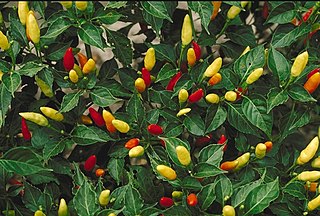
Capsicum frutescens is a wild chili pepper having genetic proximity to the cultivated pepper Capsicum chinense native to Central and South America. Pepper cultivars of C. frutescens can be annual or short-lived perennial plants. Flowers are white with a greenish white or greenish yellow corolla, and are either insect- or self-pollinated. The plants' berries typically grow erect; ellipsoid-conical to lanceoloid shaped. They are usually very small and pungent, growing 10–20 millimetres (0.39–0.79 in) long and 3–7 millimetres (0.12–0.28 in) in diameter. Fruit typically grows a pale yellow and matures to a bright red, but can also be other colors. C. frutescens has a smaller variety of shapes compared to other Capsicum species. C. frutescens has been bred to produce ornamental strains because of its large quantities of erect peppers growing in colorful ripening patterns.

Capsicum chinense, commonly known as a "habanero-type pepper", is a species of chili pepper native to the Americas. C. chinense varieties are well known for their unique flavors and many have exceptional heat. The hottest peppers in the world are members of this species, with a Scoville Heat Unit score of 2.69 million measured in the C. chinense cultivar, Pepper X in 2023.

Ají dulce, ají cachucha, quechucha, ajicito, or ají gustoso is any of a variety of sweet perennial peppers found in Latin America and the Caribbean. It is most widely known in Cuba, Jamaica, Puerto Rico, Dominican Republic and Venezuela, where it refers to a specific native variety of Capsicum chinense that is related to the habanero but with a much milder, smoky flavor. In the English-speaking Caribbean, it is known as seasoning pepper and is essential to a variety of traditional dishes.

Capsicum baccatum is a member of the genus Capsicum, and is one of the five domesticated chili pepper species. The fruit tends to be very pungent, and registers 30,000 to 50,000 on the Scoville heat unit scale.
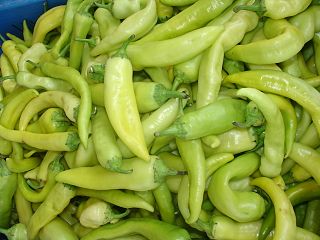
The banana pepper is a medium-sized member of the chili pepper family that has a mild, tangy taste. While typically bright yellow, it is possible for them to change to green, red, or orange as they ripen. It is often pickled, stuffed or used as a raw ingredient in foods. It is a cultivar of the species Capsicum annuum. Its flavor is not very hot and, as is the case with most peppers, its heat depends on the maturity of the pepper, with the ripest being sweeter than younger ones.
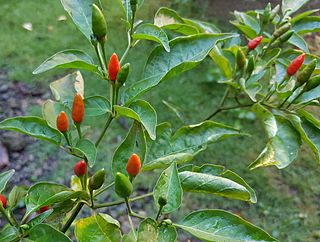
Siling labuyo is a small chili pepper cultivar that developed in the Philippines after the Columbian Exchange. It belongs to the species Capsicum frutescens and is characterized by triangular fruits which grow pointing upwards. The fruits and leaves are used in traditional Philippine cuisine. The fruit is pungent, ranking at 80,000 to 100,000 heat units in the Scoville Scale.
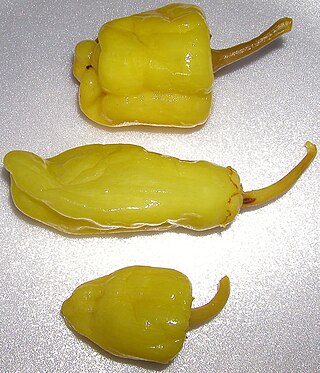
The friggitello is a sweet Italian chili pepper of the species Capsicum annuum. It is also known as the Golden Greek pepper, Sweet Italian pepper, or Tuscan pepper. In the United States they may be called "pepperoncini"; they are quite distinct from Italian peperoncini, which are hot Italian chili peppers. In the United States, they may also be called "Greek golden pepperoncini peppers" or "mild golden Salonika peppers". The friggitello is mild with a slight heat and a hint of bitterness, and is sometimes pickled and sold in jars. In Italy the friggitello is most associated with Tuscany. The Greek variety, which is sweeter, is commonly used elsewhere in Europe and the United States.

The peter pepper, Capsicum annuum var. annuum, is an heirloom chili pepper that is best known for its unusual shape. It is a type of Capsicum annuum, though it is not officially recognized as a cultivar of the species. It occurs in red and yellow varieties. The pepper is considered very rare and its origin is unknown.

Crushed red pepper or red pepper flakes is a condiment or spice consisting of dried and crushed red chili peppers. This condiment is most often produced from cayenne-type peppers, although commercial producers may use a variety of different cultivars, usually within the 30,000–50,000 Scoville unit range. Often there is a high ratio of seeds, which are erroneously believed to contain the most heat. Crushed red pepper is used by food manufacturers in pickling blends, chowders, spaghetti sauce, pizza sauce, soups and sausage.

The Cheongyang chili pepper (Korean: 청양고추) is a medium-sized chili cultivar of the species Capsicum annuum, with intensity of 10,000 Scoville heat units. Cheongyang chili peppers look similar to regular Korean chili peppers, but are many times spicier.

Bird's eye chili or Thai chili is a chili pepper, a variety from the species Capsicum annuum native to Mexico. Cultivated across Southeast Asia, it is used extensively in many Asian cuisines. It may be mistaken for a similar-looking chili derived from the species Capsicum frutescens, the cultivar siling labuyo. Capsicum frutescens fruits are generally smaller and characteristically point upwards.

Capsicum is a genus of flowering plants in the nightshade family Solanaceae, native to the Americas, cultivated worldwide for their chili pepper or bell pepper fruit.

The cayenne pepper is a type of Capsicum annuum. It is usually a moderately hot chili pepper used to flavor dishes. Cayenne peppers are a group of tapering, 10 to 25 cm long, generally skinny, mostly red-colored peppers, often with a curved tip and somewhat rippled skin, which hang from the bush as opposed to growing upright. Most varieties are generally rated at 30,000 to 50,000 Scoville units.
The Sandia pepper or Sandia chile pepper is a New Mexico chile pepper cultivar of the species Capsicum annuum with a scoville rating which ranges from mild to hot. This cultivar is extensively grown in New Mexico where it was developed and is popular in New Mexican cuisine. Sandia peppers picked while still green are typically roasted to produce green chile. When ripened, this variety can be dried and ground to make chile powder. Sandia peppers grown and consumed in New Mexico are most commonly used to make red or green posole, green chile stew, and carne adovada.
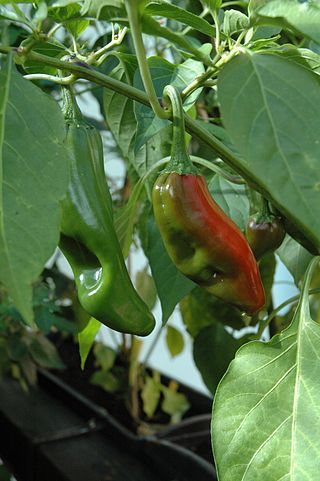
The Big Jim pepper is a New Mexico chile pepper cultivar of the species Capsicum annuum with a Scoville rating of mild. This cultivar is extensively grown in New Mexico where it was developed and is popular in New Mexican cuisine. Big Jim peppers are both sweet and mild and are normally picked while still green. The fruits are large and thick walled, often exceeding over a foot in length, and they are almost exclusively used to produce roasted green chile in New Mexican cuisine.

















